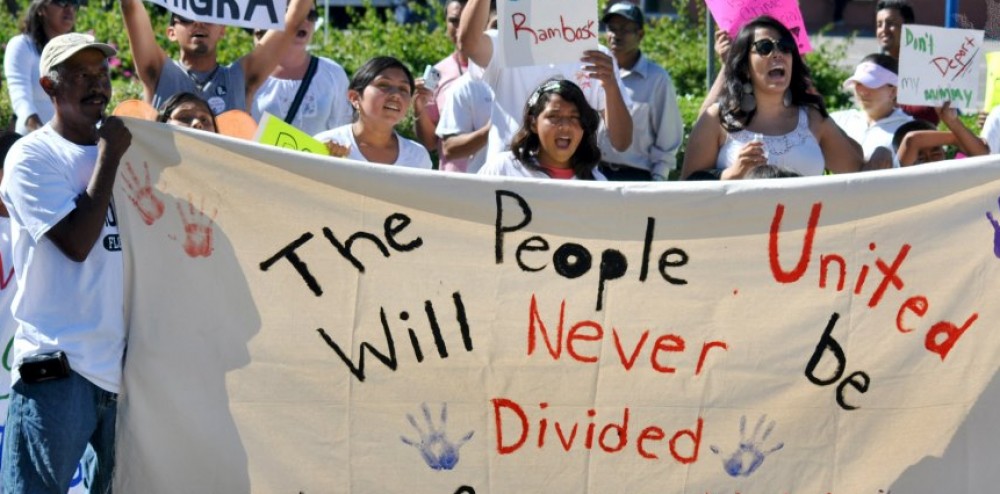Under Attack
Our local project continues getting calls from community residents who are sharing horrible stories of fear, persecution and family separation. We are in the 21st century and freedom for some is yet to come.
In the weekend paper, we see a story on checkpoints, a policing practice that is funneling fathers, mothers and children into the immigration system. If it wasn’t bad enough that our communities are taking hit from the polimigra and these practices, we are taking one from local residents who simply don’t understand that there are “lawbreakers” in their midst. They don’t quite get why it would be necessary for someone to drive a car without a license.
“I mean, really, how can these people not have a license? Get in back of the line!” This was one of the better behaved comments on the local news website. If it only were as simple as getting in the back of the line or getting licenses.
The calls keep on coming and they don’t have an end in sight. So we are doing what we can–sharing these testimonies far and wide, reaching to our media contacts and pressuring the local sheriff to stop the madness.
Three local cases expose the injustices that exist in the collaboration between police and immigration agents in our local Southwest Florida community.
The Power of Collective Voice
This week, we launched two petitions and a bond fund to fundraise for our third local case.
The way it works is that when we can and when the family consents, we launch petitions and spread the news of a local deportation case underway. We are only able to because the family has consented to move forward. Most of these individuals have lawyers and so, they are seeking an extra way to push and pressure for their loved one’s release. Additionally, they know that they are not the only ones undergoing this struggle. There are many others like them and they know how important it is to raise their voice in support of those very people.
Collective voice is powerful and it become pivotal in an area so drastically pummeled by conservative politics as well as insidious programs like SCOMM and 287g. Collier County immigrant families are finally understanding the waves of change and are using their voice to create the current.
Here are three stories that merit attention not only for the indecency and injustice that is being committed against them, but for their bravery in sharing their struggle with the rest of us.
Injustices left and right: At the mercy of police and ICE
#1 Jose Melgar
Sign his petition

After being detained for approximately a week and a half, Jose’s mother decided to speak out on the injustice that is taking place in her son’s case.
Jose was picked up by Collier County police and ICE agents at his Fort Myers home on April 9th.
With no provocation, he was beaten repeatedly and both his mother and sister were threatened with the same treatment.
He is currently being held in Krome Detention Center in Miami, where he currently sits awaiting for possible deportation. We are doing all we can to make sure that he is reunited with his mother.
We started a petition for him 24 hours ago and already we are seeing an outpouring of response and support! Please help us get to our goal of 1,000 signatures!
#2 Alexis David

Alexis, here shown with his little sister, was picked up by Collier County police department about two months ago.
He is currently being held in Krome Detention Center.
At 18 years old, Alexis has endured much more than any other one of his peers at his age. By the same token, his family have been under a lot of stress trying to coordinate what do for him.
This morning, after much push to get him a bond hearing and get him released, we were alerted that we had a breakthrough.
Alexis was granted a $2500 bond and can be released upon payment. However, the fight isn’t over. His family, who have been financially strapped, are unable to pay the full amount. His mother, Adolfina, will start fundraising at her local church selling dinners and snacks to local parishioners in hopes of fundraising the money. On our end, we want to help and we have started a bond fund for him.
This service, provided by Chipin, is Paypal supported, which means is safe and trustworthy.
Click here to donate and help us get Alexis back to his family!
#3 Eliberto Orozco
 Eliberto, a father of four US born children, was picked up in March near his Immokalee home for driving without a license.
Eliberto, a father of four US born children, was picked up in March near his Immokalee home for driving without a license.
Due to a past deportation order, which was issued due to a missed court hearing, Eliberto is now being held in Collier County Jail awaiting his transfer to Krome Detention Center.
He has left behind 4 daughters, one of which has a possible hear condition. His wife, Bertha, is unable to work due to the fact that she takes her of her youngest daughter and has enough money to last her for two months.
If Eliberto is deported, Bertha and her kids risk not being able to support themselves.
Please help us get this family reunited by signing his petition!


 On April 9th, Jose Melgar was on his way home from a trip to the grocery store with his mom and sister. Before reaching their house in Fort Myers, Florida, the family was surrounded by Immigration and Customs Enforcement agents who demanded to see their documents. Ana requested permission to retrieve documents from their home and asked officers if they had a warrant. But, without producing a warrant, they entered the Melgar home, ripping through belongings, while Ana got her paperwork.
On April 9th, Jose Melgar was on his way home from a trip to the grocery store with his mom and sister. Before reaching their house in Fort Myers, Florida, the family was surrounded by Immigration and Customs Enforcement agents who demanded to see their documents. Ana requested permission to retrieve documents from their home and asked officers if they had a warrant. But, without producing a warrant, they entered the Melgar home, ripping through belongings, while Ana got her paperwork.


